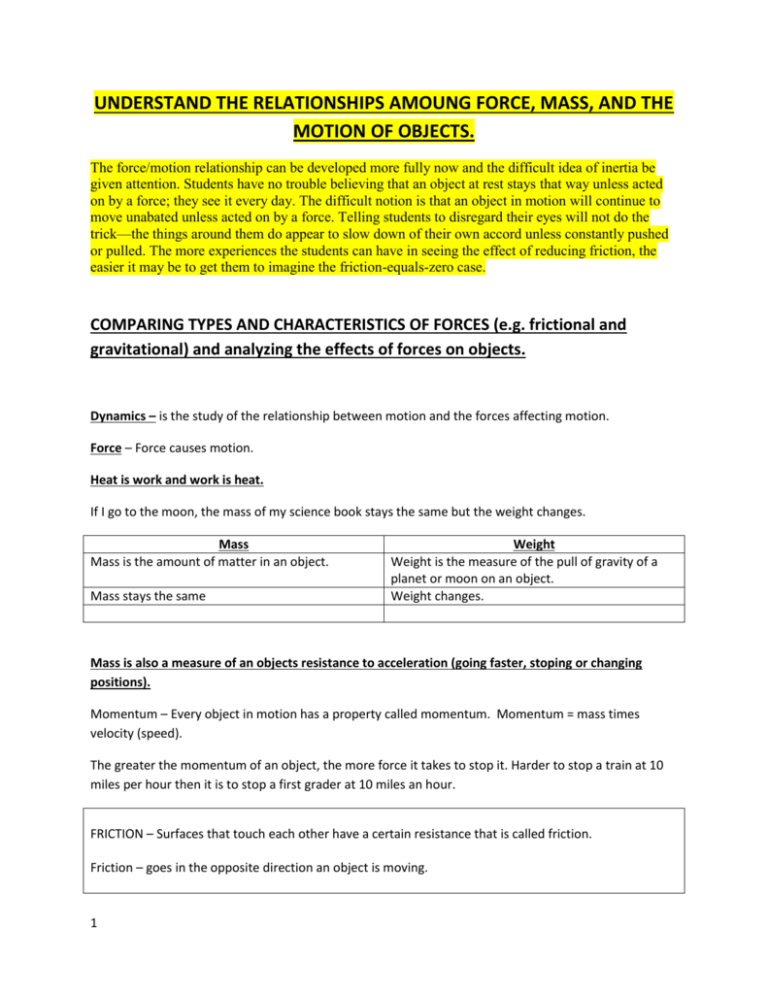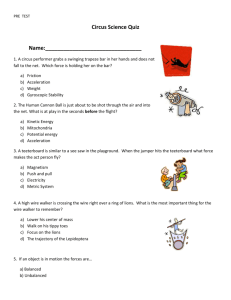understand the relationships amoung force, mass
advertisement

UNDERSTAND THE RELATIONSHIPS AMOUNG FORCE, MASS, AND THE MOTION OF OBJECTS. The force/motion relationship can be developed more fully now and the difficult idea of inertia be given attention. Students have no trouble believing that an object at rest stays that way unless acted on by a force; they see it every day. The difficult notion is that an object in motion will continue to move unabated unless acted on by a force. Telling students to disregard their eyes will not do the trick—the things around them do appear to slow down of their own accord unless constantly pushed or pulled. The more experiences the students can have in seeing the effect of reducing friction, the easier it may be to get them to imagine the friction-equals-zero case. COMPARING TYPES AND CHARACTERISTICS OF FORCES (e.g. frictional and gravitational) and analyzing the effects of forces on objects. Dynamics – is the study of the relationship between motion and the forces affecting motion. Force – Force causes motion. Heat is work and work is heat. If I go to the moon, the mass of my science book stays the same but the weight changes. Mass Mass is the amount of matter in an object. Mass stays the same Weight Weight is the measure of the pull of gravity of a planet or moon on an object. Weight changes. Mass is also a measure of an objects resistance to acceleration (going faster, stoping or changing positions). Momentum – Every object in motion has a property called momentum. Momentum = mass times velocity (speed). The greater the momentum of an object, the more force it takes to stop it. Harder to stop a train at 10 miles per hour then it is to stop a first grader at 10 miles an hour. FRICTION – Surfaces that touch each other have a certain resistance that is called friction. Friction – goes in the opposite direction an object is moving. 1 Friction depends on 1) the type of surfaces touching and 2) how hard the surfaces are touching. Four types 1. Static friction – two surfaces in contact that are not moving. The table and the floor. 2. Rolling friction – friction of a car wheel. 3. Sliding friction – pushing a box across the floor or your shoe on the ground. 4. Fluid friction – friction in air (air resistance) and liquids (water). Analyzing the relationship between the displacement, velocity, and acceleration of an object graphically, algebraically, and in written form. To have movement, there must be a change in distance between two objects. Speed is how fast and object is traveling. Speed = distance / time. Velocity - gives me the direction as well as the speed. How fast and object is traveling and in which direction it is traveling. Instantaneous Speed – speed at a given instant. Centripetal force – When an object moves in a circle, the centripetal force is the force that directs the object toward the center of the circle and keeps it the object from going in a straight line. The earth’s gravity is the centripetal force that keeps a satellite and the moon going in a circle. Average Speed - The average of all instantaneous speeds. Total distance / Total time. ACCELERATION - Is the rate at which an object changes velocity. Said another way it is the change in speed (faster or slower) or the change in direction (going in a circle). Acceleration = (final velocity – starting velocity) /time. Using Math – This is easy. The stream is traveling down river at 4 mph. The man in the boat is rowing from one side of the river to the other at 3 mph. The river is 3 miles across. At the end of an hour, how far did he row. This is a right triangle with a = 3, b = 4. 3 squared + 4 squared = x squared. 9 + 16 = 25. The square root of 25 = 5 so he traveled 5 miles from where he started. 2 Newton’s laws of motion and applying them to everyday situations. Newton’s Three Laws of Motion 1. The law of inertia –Objects at rest will remain at rest until acted on by an external force and objects in motion will remain at motion traveling at a constant velocity (at same speed in a straight line) until acted upon by an external force. On earth, friction is an external force that slows objects down. 2. Force = mass times acceleration. Memorize the formula. If a net force acts on an object, it will cause the acceleration of an object (go faster, slower, stop, change direction). 3. For every action, there is an equal but opposite reaction. When I kick a soccer ball, I exert an equal but opposite force on the ball and the ball exerts a force on your foot. Don’t believe me, try kicking a wall. PUSH AND PULL – Pushing a table or pulling a bowstring applies a muscular force when the muscles expand and contract. This is an elastic force when any object returns to its original shape (your muscles or the bow string). RUBBING – Friction opposes (goes in the opposite direction) the motion of one surface going past another. The air hitting your face on a bicycle or the friction of the ground on a tire. PULL OF GRAVITY – Any two objects, any two molecules, any two atoms have a force of attraction between them called gravity. Basically, positive electrons of one object are attracted to negative electrons of another object and vice a versa. FORCES ON AN OBJECT AT REST – When all the forces on an object are balanced, the law of inertia says that the object does not move and continues to remain at rest. A boat wants to float down the river because of the force of the water but the force of the rope holding the boat to the dock is greater and the boat does not move. FORCS ON A MOVING OBJECT – When forces are balanced, the law of inertia says that the object continues traveling at the same speed and in the same direction. INERTIA AND CIRCULAR MOTION – The high banking of a curved race tack and the friction between the wheels and the road keep an object moving in a circle called centripetal force. Using Math Which has more momentum a 3600 kilogram truck moving at 8 kilometers per hour or an 1800 kilogram truck moving at 16 kilometers per hour. Momentum (force) = mass times acceleration (speed). Truck = 3600 kg x 8 km/hr = 28800 kg/km/hr Car = 1800 kg x 16 km/hr =28800 kg/km/hr. What if the truck and car are moving at the same speed of 8 kilometers per hour The car has ½ the momentum. Car = 1800 kg x 8 km/hr = 14400 kg/km/hr. 3 APPLYING KNOWLEDGE OF CONEPTS OF WORK, POWER, EFFICIENCY, AND MECHANICAL ADVANTAGE. Work Work is done on an object when a force is applied and the object moves some distance. IF the object does not move, no work is done. Work = force times distance. Power Power is the rate at which work is done or how fast work is done. Power = the amount of work divided by time. Walking and running the same distance do the same amount of work but running requires more power. Efficiency The law of conservation of energy says that energy cannot be created or destroyed. It may be transformed from one form to another but the total amount of energy never changes. Efficiency is the relationship between the energy input and the energy output. A car loses some efficiency as energy is transformed to heat and sound rather then making the car move. % Efficiency = useful energy produced times 100 divided by total energy used. Mechanical Advantage There are two types of mechanical advantage. 1. Ideal mechanical advantage – no energy is lost from friction, heat, light, sound, etc. 2. Actual mechanical advantage – The mechanical advantage the is found in the real world where some energy is converted into wasteful forms that are not useful. Remember if distance goes up, force goes down but total work is always the SAME. Think of a ramp compared to stairs. I work to make money to buy my lovely wife some joules. Ask me what power is measured in? Watt? I use force to open up my bag of fig neutons and eat them. So work is measured in joules, power is measured in watt, and force is measured in neutons. 4 IDENTIFYING TYPES AND CHARACTERISTICS OF SIMPLE MACHINES. 6 types of Simple Machines 1. 2. 3. 4. 5. Inclined plane Lever Wheel and axle Pulley – Changes direction of the force. Wedge – two inclined planes – the wedge moves doing the work over a greater distance so less force. 6. Screw – an inclined plane wrapped around. Compound machines are two or more simple machines working together. A wheelbarrow is a lever and a wheel and axle working together. Increase efficiency by decreasing friction. 3 types of levers See saw, scissors, pulling a nail with a hammer. First class lever = The fulcrum is between the effort force and resistance force. Second class lever = The resistance force is between the effort force and the fulcrum. Wheel barrow, pecan cracker, or a bottle opener. Third class lever = The effort force is between the resistance force and the fulcrum. Raking leaves, hitting a baseball, using a fishing rod. First class lever Second class lever Third Class lever Middle Fulcrum pivot. Resistance Effort force 5 Effort Force Effort Force Resistance force Resistance force Fulcrum pivot Fulcrum pivot.





